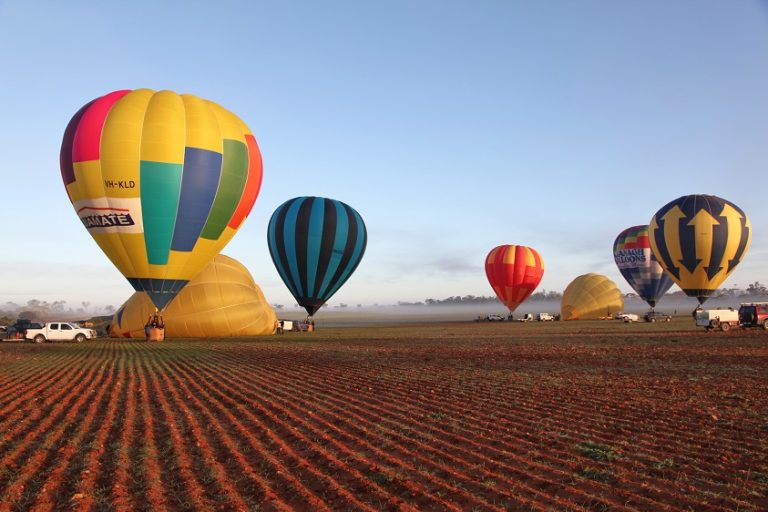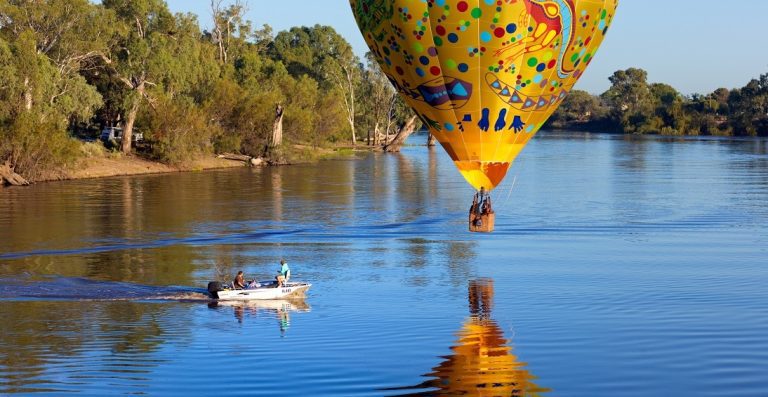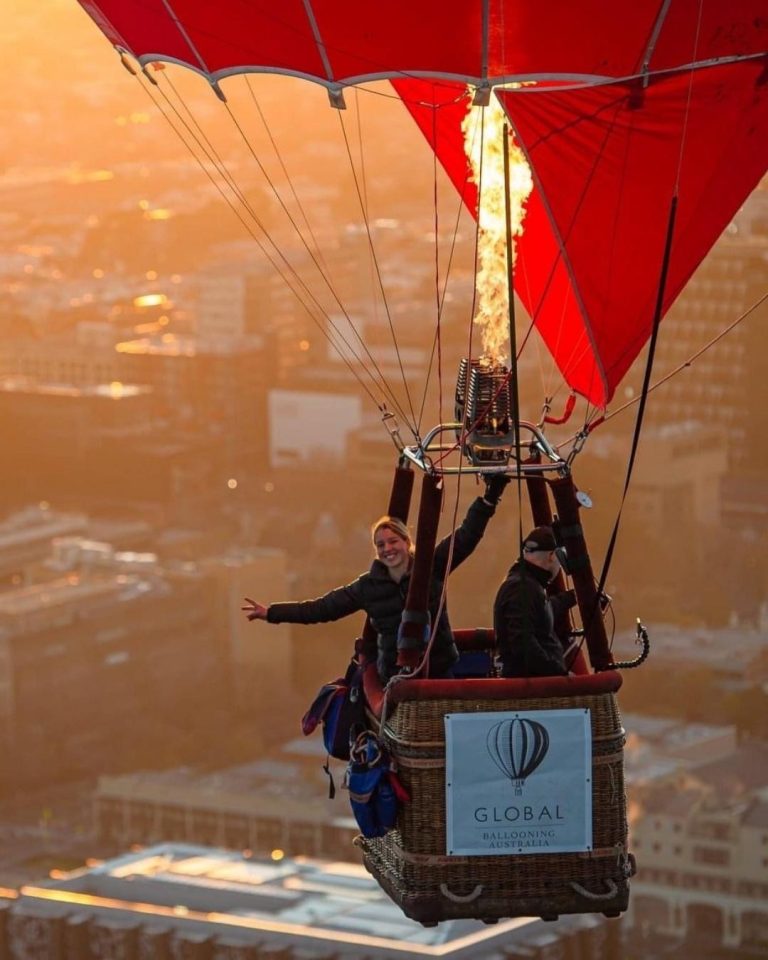For the Global Ballooning Team this means spending the short freezing daylight hours on the stimulating task of maintaining equipment and catching up on administration work. It is little wonder we spend our evenings religiously studying forecasts for any opportunity to get out of the shed or office and into the air.
This year’s winter has been particularly cold and bleak so with escape in mind we again seized the opportunity to placate our desperation to find something to challenge us.
Ronald our resident ideas man had suggested that my daughter Scarlett should have a crack at the Australian Women’s Altitude Record before the proposed changes to Class E Airspace are enacted and the height limit lowered. His suggestion all the encouragement we needed and so an expedition was planned.
For those who have not met Scarlett, I will give you a little background information. She is 18 years old, has been around balloons all her life, attained her PPL at 17 and is currently completing her final year of school. For those who know her brothers Pat and Ed all I can say is that she is nothing like them. She is quiet, capable, humble and far more academically applied than her rambunctious brothers. In suggesting that she have a crack at the Women’s Altitude record with less than 20 hours, as PIC, Scarlett was undaunted by the proposal and in her own reserved way somewhat enthusiastic.
Adventure flights do not occur without some and hopefully lots of planning. Altitude flights have an even greater dimension of required understanding as they also involve human physiology along with the technical aspects associated with air density/pressure. To Scarlett’s credit she read the attitude material, studied the Oxygen System she was using and practiced the emergency and safety procedures that may be required during the flight. Actually in looking back she was far more thorough in her research and understanding than I have been on similar flights. As it turned out her research and practice really aided her during what ended up being quite a technical flight.
For those who may not be aware of the concept of going high I will provide brief overview. Our atmosphere is made up of approximately 78% nitrogen 21% Oxygen and 1% other stuff. Nitrogen is absorbed through the muscular system whilst oxygen is filtered through the lungs into the blood. When you climb fast the Nitrogen and Oxygen molecules expand – the lungs can handle this but the muscular system cannot release nitrogen which may result resulting in what is referred to as ‘The Bends’. This is certainly a factor to consider when climbing fast and high. The other factor is that at 6000 metres the air pressure is half that at sea level – given air pressure and air density are proportional (whilst the make of the atmosphere remains the same) the resultant drop in pressure reduces the lungs capacity to absorb Oxygen. Basically this means at 20000ft【6 096 m】 your lungs are working at about 75% capacity. At 4000 metres pilots enter what is know as the zone of indifference and at 7000 metres pilots are entering what is regarded as the death threshold. This is where pre-breathing and saturation of oxygen within your system become essential.
Outside of the human physiology, a pilot must consider the effect of high altitude on the equipment; overall lift, burner output and functionality, avionics functioning properly at height and temperature and of course the actual oxygen delivery system. Last on the check list of considerations are of course airspace restrictions.
Scarlett’s altitude record attempt was arranged to be launched at Deniliquin in Southern NSW where the Class E airspace has an upper limit of 24500 ft【7 468 m】. Our aim was to set a Woman’s record that would be hard to beat, particularly given the proposed upcoming changes which will make Class E airspace a uniform 18000ft【5 486 m】 level across Australia. To fly above Class E airspace in to Class A (IFR) airspace requires a complete change in the required instrumentation one must have on board. Balloon pilot must seek approval from CASA to perform such a flight, which needless to say makes chasing the record far more technical to achieve.
About the flight itself – The chosen day 4 July 2019 was probably not ‘the most’ ideal given the forecast indicated a fast low-level jet below an upper-level inversion along with the likelihood of relatively brisk surface winds. Given we were working with in a school holiday weather window, it really came down to soldiering on, being on the spot and cancelling on the field if required. Scarlett and her team (Ronald, Georgia, Tash, Belinda and dogs) prepared all their gear and three balloons trailers took off to Deniliquin to scope out launch sites. Eddie and I followed them up the highway a little later and by evening we were all in the ‘Deni RSL’ having a team meeting to establish protocols. Three balloons were going to be flying – two heading up high whilst Georgia and Belinda practiced their fast wind flying skills. (Ronald Kent had decided to fly his little 56 next to Scarlett to tick a high-altitude flight off his personal bucket list of ballooning achievements)
The early morning start saw brisk conditions, clear sky and a healthy 8-12kts on the surface. The low level jet was plainly noticeable as we watched the Pi-Bal shoot off in a relatively flat trajectory just over the top of the powerlines racing towards the Southwest. The good news to calm our nerves was that we had chosen a flying area with big flat open countryside, so any fast landing just needed to be prepared for rather than avoided – all we needed was a little inversion to form to allow for a relatively calm inflation. It was still quite breezy on our arrival at our footy oval launch field near the river so we decided to just slowly set up all the balloons and wait to see the wind might drop out enough for a launch. Given our main aim was to get Scarlett in the air, the team focused on preparing her basket with all the gear ‘in and on’ and locked in place in preparation for a fast landing. Just for a reference this equipment include VHF/UHF radio’s Barograph, 2 x GPS, Temperature sensor, moving map multiple igniters and the mountain high oxygen system. Everything was strapped, taped and firmly secured so that if the inflation was windy she could just get the balloon standing and go. Once our first task was completed Ronald’s balloon was then prepared in the same manner.
As with these types of flights there is a little nervous energy on display and given I was sending my daughter up to over 7000 metres on a fast wind day I was particularly focused on everything being in order. Scarlett on the other hand was as cool as a cucumber – just working on preparing for the flight and taking on last minute instructions. Luckily for all the wind backed off to about 5kts on the surface at the launch site and the inflations began. It was fortunate that the balloons could stand without too much movement, which allowed everyone a chance to relax and complete the final flight preparations without rushing. Both Scarlett and Ronald where connected up to their Oxygen Systems and Scarlett lead the way with a fast climb out of the launch field closely followed by Ronald a few minutes later.
The climbing to altitude itself was completed fairly swiftly with the balloons maintaining an ascent of 1000ft【305 m】 per minute. Once they passed the 10000ft【3 048 m】 mark the wind shifted backwards and into a light southerly wind, which they maintained to the maximum achieved altitude. The winds shifting and slowing had been anticipated on the model forecasts and ensured that the two balloons remained in the higher Class E step. Scarlett experienced multiple pilot light failures above 13000ft【3 962 m】 with her Cameron MK4 Super burners and was very happy to have learnt how to relight by using a low liquid fire release rather than attempting to relight the actual pilots lights. Ronald on the other hand with his old Kavanagh Burners had no such issues.
Ronald had been managing the communication with Melbourne Centre via VHF radio just to keep them informed of the balloons at high altitude over Deniliquin. There is no actual requirement for permission but for VFR aircraft to seek a clearance in Class E airspace although Melbourne Centre did reply and took a keen interest. It was agreed that it would be best to give some separation between the upper-limit so Scarlett stopped her burning once passing 23000ft【7 010 m】. The official altitude achieved once the balloon stopped climbing was 23714ft (7228.21m). On video Scarlett is heard to express her sheer delight with a simple “Woo-hoo” before terminal descending her balloon back down below 500oft in preparation to for landing.
Landing itself was the challenge that had my heart beating a little faster than usual as on the deck I was looking a good 12-15 knots and Ronald was reporting 40km/hr winds at 500ft【152 m】. With wet paddocks and not many tracks I was keen to catch Scarlett as she came in to land. This was not to be the case as it was too fast for me to get to the paddock, so when I finally caught up to her she was on the ground and quietly packing the balloon. Without any great fanfare we loaded the gear and drove back to ‘Deni’ to join the rest of the team for breakfast to celebrate achieving our goal. Needless to say we were all very proud of her poise and persistence to take such a challenge on. Not an easy flight for a young balloonist and certainly one that required considerable courage.
Given I had flown next to Ronald Kent on his record breaking AX-6 distance flight last year, I was inspired to have a go at officially setting a new absolute National Distance Record. The requirement for such an attempt is to have cool conditions, fast upper wind and a track that hopefully takes you in to big open countryside for a fast landing.
When studying forecasts for opportunity one must have the ability in ballooning to move quickly. I had not really set a date for a record attempt, I was just surveying WX models to see what flights might present given we also had on the agenda another flight Snowy Mountains crossing again this year. The main component for a distance flight is wind in excess of 50 -60kts at altitude.
As it turned out we were experiencing a very robust series of weather system bringing completely lousy windy weather to most Victoria. This was the same weather pattern that kept the students on the ground at Lake Coleraine for most of the later part of the week.
The trick with setting a distance record is you have to trade off fast surface wind against having enough speed at height, as it is rare that you are likely to launch in calm conditions and then find 100km/hr winds at altitude.
As it turned out the WX conditions required looked ‘marginally’ favourable for an attempt on Thursday 11 July and so gear was packed and Pato, Scarlett, Ed, the dogs and I took off on speculative road trip to Pinnaroo in South Australia. Our initial aim was for Scarlett to have a go at setting a women’s distance record by conducting a 200km flight next to me in her little blue 77 – with Pat and Ed following in the two chase vehicles as official observers.
Pinnaroo is a small wheat-belt town in the western Mallee region located just on the SA side of the border with Victoria. Our arrival at Pinnaroo in the late afternoon during a rain/dust storm did not fill any of us with confidence that there would be much flying occurring. The consensus was that we would be most likely be doing more than enjoying a nice road trip and pub meal. Pinnaroo is surrounded by very flat cropped countryside with little protection and so our search for a lovely protected launch site was completely fruitless. It was agreed we should remain positive, stay the night and just hope for the chance of a windy 10kt launch from the local footy oval in the morning. We also agreed on a contingency plan that involved hitting the road early to drive a 100km north to Loxton with hope of finding better protection from the wind along the the Murray River.
To all our credit we maintained a positive attitude and prepared all the gear for a potential early departure although to be honest we probably could have spent some productive time caching and studying maps rather than playing pool at the local pub. Sleep that night was buffeted by the sound of the blustering wind as the passing cold front heaped its rain and fury on our little truck stop motel. Cookie and Zephyr where certainly far from impressed at having to sleep in the car during the storm.
Given I was the commander of this expedition the kids speedily voted 3-1 that I would be early morning weather check and alarm clock guy moments before the boys raced off to their room to catch the final half of the State of Origin. My 4.30am WX wake up duties confirmed my overnight suspicion, we would have to relocate North if I was to have a chance of getting off the ground. Although the front had passed and the sky was clear it was still a good 15kts on the ground at Pinnaroo with little chance in my opinion of it backing off.
There is a reason balloonists like to choose their own launch site as basically this allows us to determine where we plan to land. Pinnaroo was chosen because the anticipated flight distance of 400+ km and the projected wind direction at altitude would take me towards the Hay Plains, which provide wide-open countryside with multiple fast landing options. I had even hoped to attempt a low pass over Lake Coleraine to announce my record attempt in style to the students stuck on the ground. Driving to Loxton scuppered my carefully considered flight plan and resulted in me having to forsake a flight path over relatively civilised countryside with a higher degree of population and accessibility for a flight over the uninhabited Mallee Scrub that includes Mungo National Park and beyond.
This basically ruled out the second balloon flying with either Scarlett or one of the boys as after rain, the access on the red dirt roads is treacherous and we did not want to increase our risk profile by having to find two balloons. The AWS at Loxton airport was showing 8 -12 knots as we arrived in town, so I was comfortable that our research of a launch site down beside the Murray River would allow us to get the balloon standing. Having driven for an hour we were now in a position where we needed to get cracking to get the balloon up and away as it was clear we were in for a long day. The instigation of rushing into the equation was the first of a few errors made on this flight. As with Scarlett’s record altitude flight the previous week – it is so important to be able to be methodical and to not introduce tension into the process. Our inflation was not helped by Eddie nearly getting knocked out by Scarlett with a burner pole or Paterson wanting to focus on documenting the process. The assigning of tasks the previous evening would have been highly beneficial in ensuring that all aspects of the flight were covered.
Reminder to future self – checklists are so important. If you wish to move fast or inflate under pressure, there needs to be a mechanism that confirms all factors have been considered. A flight of 400km into the unknown is not your usual run of the mill balloon flight – there are numerous safety considerations that exist outside of just flying the balloon that require thought and implementation. In my case the preparation for flying over remote country was not planned and our relocation left me unprepared for the probability that I would land in a remote location. Such items such as food, water, effective communication equipment, emergency distress gear, good maps etc. where not on the list. My focus was on the flight not the consequences. It certainly was not helped by my rushing to get off the ground leaving behind my bag of munchies or taking the time to set up my moving map computer correctly to cover the area I was about to traverse. I would also be mindful of having the three sole beneficiaries of your estate responsible for your safe return J
The inflation and launch actually went very smoothly with the balloon envelope moving around but not thrashing about. In hindsight I could have easily spent five more minutes on preparation. My flight initial plan was to capitalise on the westerly wind down in the lower levels before climbing into the faster wind. Given I was flying a Kavanagh D77 with 6 fuel large LPG tanks I was not in a hurry to climb to above 10000ft【3 048 m】 particularly given there was still plenty of speed down low and the higher I went the more the balloon steered North away from easy landing options.
It became clear that I was not going to break any distance record if I did not climb into the higher wind speed, so I chose to put my flight into the hands of destiny and set course towards Pooncarie (the only town in my path situated on the Lachlan River) and onwards towards Ivanhoe. My climb to 12000ft【3 658 m】 had me motoring along nicely at 123km/hr. so all I had to do for the next three and half hours was to keep the pilot lights burning (very annoying), enjoy the view and see how long my fuel lasted. In regard to fuel usage, I was undone by quite high temperature which certainly affected my overall duration.
So now we get down to unplanned adventure #2 – The retrieve. If you draw line between Loxton and Ivanhoe, you will see there is no easy route other than the long way round or across the middle using dirt roads. Now when planning these adventures there is the assumption that with your lovely four-wheel drive there are few places you probably cannot go – unfortunately this logic does not take into account fine red dirt roads after rain whilst towing a trailer. Basically, there are many adventure travelers who learn the hard lesson about Australian Outback roads after storm. To the credit of Pato and Ed they did not blindly dive into the outback option that would take them through Pooncarie on a northeastern route past Mungo National Park. Stopping at Pooncarie to seek road advice provided conflicting stories from the service station and the police so they decided to split the retrieve with Ed going the long way round and Pato and Scarlett the middle route. I think it would be fair to say that the crew managed to have far more adventure than me standing in my basket for four and half hours with only a few minutes of pressure at the end.
Lessons for adventurers – plan ahead – not just for the balloon flight but also for the retrieve. Prepare for breaking down, getting stuck or getting lost. Things like food, water, additional fuel, appropriate tools, remote communication equipment and tow kits are essential.
Lastly, I would like to cover the Human Factors component of the flight. Needless to say, once I had launched there was a commitment to reach my desired goal – that being to break the National distance record. This provided me with a ‘single focus’ where all other aspects of the flight became secondary. As it happened, I did manage to land safely without incident beating Ronald’s record by the small margin of 6km, so my mission was accomplished. The thing that interested me most in hindsight, and I had plenty of time to consider this given I had to walk 17km over 5 hours whilst lost in the scrub with feral goats and kangaroos for company, was how I managed to place the goal over overall safety.
It is fair to so that at no stage did I feel at risk during the flight or whilst landing at high speed in the outback scrub. These situations are common to me so switching on for these tasks are ingrained in my DNA. What did surprise me was my competitive instincts driving me to fly into a position where there was a potential to put me in harm’s way. So, what does this mean? Well to break the record I knew I had to fly further into the remote scrub away from access to a road to make the distance. I did this without consideration of there being no mobile service, that my crew did not know where I was or that in the event of an injury on landing I would be virtually lost in the middle of nowhere with no means of communication, food and only a little water. Basically, this is what we call ‘blind faith’. My assumption was that all would be fine, so I made no effort to prepare for the worst.
Here is a statement from a book I am reading at the moment that identifies how these situations can go dreadfully wrong.
Research of aviation accidents have shown that human errors can be divided into the following categories: inattention, channelised attention, flight task saturation, delayed reaction, navigation error, lack of cooperation with other parties, inadequate agreement and overestimation of one’s own abilities.
A number of factors and conditions must come together to cause an accident. Each separate condition adds only a minimal risk of an accident, but if the conditions grow, it creates a chain that must be broken to prevent an accident. These processes can be used to recognise and break a chain of erroneous decisions.
- Proper Decision Making
- Understand causes and impact of stress
- Prudent Risk Management
- Communication
- Management of competitive instincts
- management of Social Media impacts
- Mental Training
I am happy to have broken the current distance record albeit by the slimmest of margins, although I admit to being a little disappointed that I did not surpass my proposed 400km goal. It certainly was a wonderful family adventure. After finally being found by Eddie in the dwindling last light then packing all the gear in the dark and eventually dragging my tired body back to the Ivanhoe Pub for a well-earned steak and beer with the kids was pure delight. It certainly is invigorating to get out and challenge oneself and I look forward to many more such adventures. I will leave you with the primary lesson of adventure flying that I have learned on this flight – this basically being – take the time to hope for the best but prepare for the worst.







